England’s Royal Ballet performs in New York June 23-28.
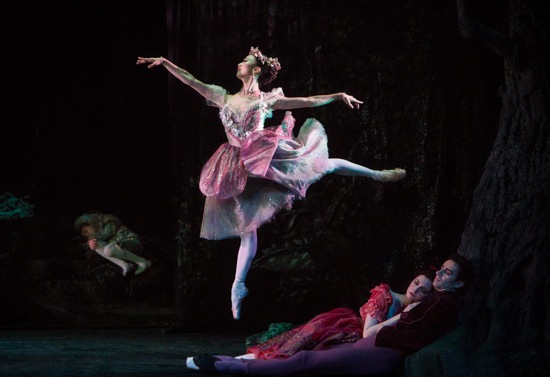
Fairy Peaseblossom (Akane Takada) flies above the slumbering lovers (Christina Arestis and Valeri Hristov) in Frederick Ashton’s The Dream. At left, sleeping alone: Johannes Stepanek. Photo: Yi-Chun Wu
Felix Mendelssohn wasn’t yet eighteen when he wrote his Overture to Shakespeare’s A Midsummer Night’s Dream. He’d only just read the play that year (1826) in German translation; it must have excited him mightily. He was over thirty when he combined the overture with incidental music to accompany a performance of Shakespeare’s moon-struck work.
When Frederick Ashton choreographed his magical ballet The Dream in 1964 in honor of the 400th anniversary of Shakespeare’s birth, it was clear that he knew the play and the music equally well. Watching the Royal Ballet perform the work during the company’s Lincoln Center season (presented by the Joyce Theater), I was struck all over again how deliciously the music evokes the play, and how deliciously Ashton ushered them both into dance life. In the overture (superbly conducted by Barry Wordsworth and played by members of the New York City Ballet Orchestra), you can already hear the skittering fairies, the braying of Bottom the Weaver transformed into an ass, the ceremonious court of Athens, and the squabbling lovers who wander into the nighttime forest. The incidental music, as arranged by John Lanchbery, bonds fluently with the dancing and the drama. And the presence in the pit of the expert Brooklyn Youth Chorus to sing Mendelssohn’s several songs added greatly to these New York performances.
If you know the play, some of its words ring in your head when certain dance-and-music passages occur in the ballet. The fairy queen Titania’s challenge to her mate, Oberon: “The fairy land buys not the child of me.” Puck’s obedience to the command of Oberon, his master, to hasten on his mission: “I’ll put a girdle round about the earth in forty minutes.” Demetrius to the amorous Helena: “I love thee not, therefore pursue me not.” Titania to Bottom transformed, as she strokes his donkey ears: “O, how I love thee! How I dote on thee!” And, although Ashton abridged the action of the play, he expanded one line spoken by Oberon upon being reunited with Titania—“Sound, music! Come my queen, take hands with me.”—into one of the loveliest pas de deux ever created.
This production of The Dream was coached by the Royal’s Guest Principal Ballet Master Christopher Carr and by Anthony Dowell, the ballet’s original Oberon. It retains David Walker’s designs, with the immense gnarled tree in whose hollow trunk Titania sleeps, and the costumes for her fairy throng that allude to the head wreaths and longish tutus that Marie Taglioni and her ilk wore in the 1830s. The members of the Royal Ballet are wonderfully expressive in their dancing. Their expertise in mime and acting, the pliancy of their bodies and the clarity of their focus bear the story’s atmosphere and emotions along wonderfully well. Their style in this ballet of Ashton’s is more modest than the style of the New York City Ballet dancers we’re used to seeing on that stage. The positions of their arms seem rounder; they’re buoyant but not aggressive in space (unless aggression is called for). The fairies not only have swift and pretty feet, they regard their own with pleasure. When each raises a hand to her ear in that well-known evocation of “hark!” she looks both like an alert woodland creature and a figure from a ballet lithograph.
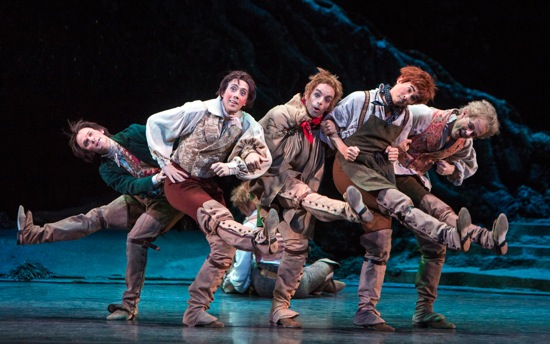
Shakespeare’s rustics (L to R): James Wilkie, Erico Montes, Sander Blommaert, Benjamin Ella, Kevin Emerton. Photo: Yi-Chun Wu
In the cast that I saw, all the dancers performed marvelously. Christina Arestis (Hermia), Valeri Hristov (her Lysander), Itziar Mendizabal (Helena), and Johannes Stepanek (Demetrius) pursued, squabbled, got mixed up, and fought fiercely as Shakespeare’s human lovers. Bennet Gartside played Bottom with the sly doltishness required and performed his donkey-headed solo on pointe neatly (how brilliant of Ashton to have devised this substitute for hooves!). James Hay vaulted brilliantly in the antic choreography Ashton devised for Puck; his frequently cocked wrists, bent knees in the air, and arms crooked at the elbow give the character a look that goes with his name. Steven McRae, regal as Oberon, danced his demanding and very interesting solo with aplomb and looked handsome in his green outfit. At first, I found Sarah Lamb’s Titania a trifle too pert, but she somehow matured as the ballet progressed and, in the end, was lovely.
The final pas de deux, set to Mendelssohn’s ravishing Nocturne, begins flirtatiously and builds through exaltation to surrender. When Titania and Oberon pull on their clasped hands (no, you go first; now follow me) their back-and-forth emerges as a lyrical, rhythmic flow. In the almost awkward maneuver when he dips her body down in her arabesque, turns her slowly once, and brings her back up into a proper arabesque, you can envisage a kind of erasure of the quarrel and renewal of their affection. Titania repeatedly darts out onto one toe, then sinks in her partner’s grasp, yielding to him gradually, as if her limbs were growing heavy with amorousness.
The Dream shared the program with Kenneth MacMillan’s Song of the Earth, choreographed for the Stuttgart Ballet in 1965 and acquired by Ashton, then Director of the Royal Ballet, for that company in 1966. The music that inspired MacMillan was Gustav Mahler’s gorgeous song cycle, Das Lied von der Erde, with its text drawn from German translations of Tang dynasty poetry by the Chinese bard Li-Bai. The lyrics sung by an onstage tenor and mezzo-soprano (at these performances: Thomas Randle and Katharine Goeldner) speak of the moon, of death, of loneliness, of spring, of drunkenness.
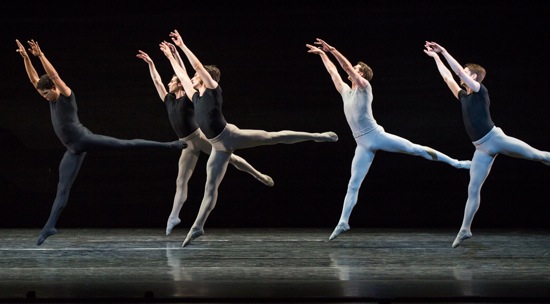
Kenneth MacMillan’s Song of the Earth. At left: Carlos Acosta. In white: Nehemiah Kish. Photo: Yi-Chun Wu
MacMillan’s much-praised ballet (this version coached by former principal dancer and company director of the Royal, Monica Mason, and notator Grant Coyle) is spare and modern—not in its dance style, but in its structure. The choreography presents clear, solid, architectural images most of the time. The young men and women in this society play, but they are not playful. They’re garbed in gray-and-white practice clothes and dance in an almost featureless space (designs by Nicholas Georgiadis) that responds to lighting by John B. Read. Among these seventeen ensemble dancers (by my count), trios and partnerships form and dissipate, people rush on and offstage, or are carried away, soloists briefly emerge. In the fifth song, Nehemiah Kish, one of the protagonists, is attended by Alexander Campbell and Ricardo Cervera. Yuhui Choe dances sweetly alone during the third song, watched and guarded by others, before being carried off by the most important of the three principal dancers.
In the cast that I saw, this character, known as The Messenger of Death, was personified by Carlos Acosta. I’ve read that this black-clad character is supposed to merge with the others and not stand out, even though he wears a half-mask that hardly looks like everyday wear. This deceptive humility is not possible with Acosta. This terrific Cuban dancer is tall, dark, and long-legged. And, when not leading the other men in the dancing or involved the more strenuous aspects of his own mission, he stands and watches the others, his posture regal. In Mahler’s text, he is The Eternal One, and he does indeed appear to have the power of Death itself.
I thought that MacMillan, in an adventurous 1960s frame of mind, might have wanted to tell a story without telling a story, swathing narrative in a veil of formality. The plot as you intermittently decipher it focuses on the dark presence of death in life. The young man (Kish) is in love with a young woman (the marvelous, luminous Marianela Nuñez). The Messenger of Death stalks the man. It is in the passages that foreground these three that MacMillan’s choreography offers powerfully expressive images. Acosta comes up behind Kish—whose own hands form a barrier in front of his eyes—and reaches around to make a further cage with his arms; then, while the two men seem welded together, Nuñez slips between them and into an arabesque, and suddenly they are her collaborating supporters. In many ways, MacMillan makes you feel the tension between these three—who might be vying with whom. At some point (I may have missed it), Kish dies. We know this because from then on, he wears a half mask too. At the end, as the music fading away, the three of them, with the woman in the middle, advance very slowly toward the front of the stage. She is not dead, but perhaps soon will be.
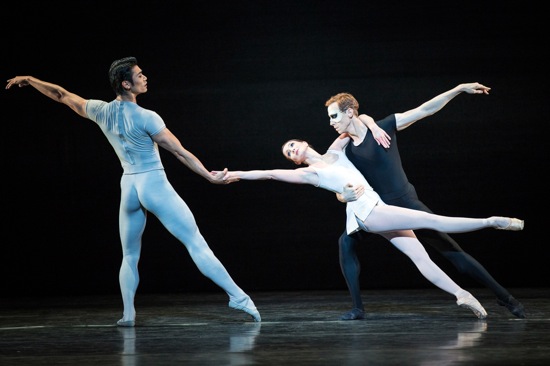
Another Royal Ballet cast in Song of the Earth. (L to R): Ryochi Hirano, Lauren Cuthbertson, and Edward Watson. Photo: Yi-Chun Wu
She is already solitary. In one resonant passage, the stage is abloom with men partnering women in the classical ways of turning them as they balance on one toe and helping them to expand into various positions. Each pair stands in one spot to do this, and several units of pairs work in canon with one another. Nuñez wanders among them, alone, and searching—aware of them only in the way that one is aware of trees when making one’s way through a forest. Just before the end, she dances alone. On pointe, she bourrées rapidly around the empty stage, often traveling backward, her feet moving so swiftly that they all but blur. She is not stiff, however; her body responds to the curving paths she is cutting, and amazingly accurate though she is, she manages also to look wayward, lost, despairing.
Watching Song of the Earth, I too feel somewhat lost. The contrast between highly expressive movement and dancing that is opaque in terms of atmosphere and significance unsettles me. At one point, I wonder if MacMillan wished to present life as a ballet class, in which disruptions surfaced like fragments of a rehearsal for an unknown production.
I regret that I was unable to see the other programs that the Royal Ballet brought to New York. Others will have seen an anthology of divertissements by various choreographers, including Christopher Wheeldon, as well as Wayne McGregor’s Infra and Liam Scarlett’s The Age of Anxiety (set to the same Leonard Bernstein work that Jerome Robbins used for his Age of Anxiety in 1950).
Anyone who missed this short New York season by the Royal Ballet can see the company, as well as the Royal Opera, in a dozen live screenings that begin in September and continue into June, 2016.

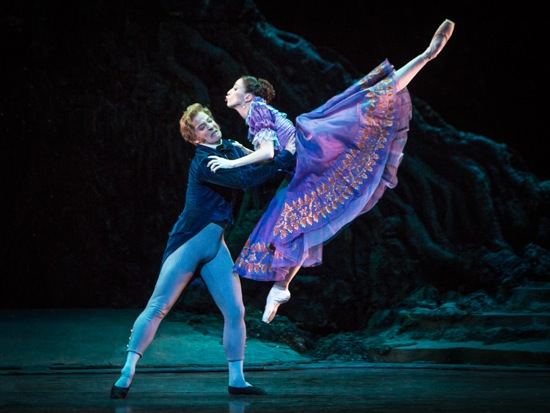
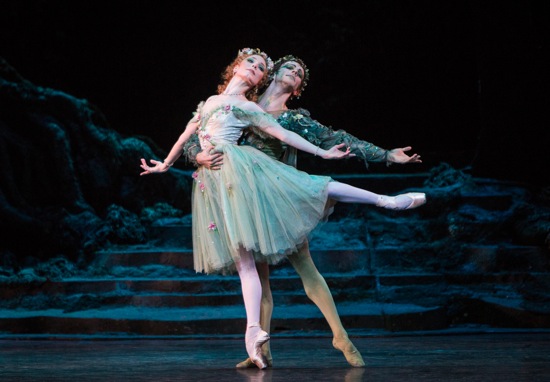

I had the pleasure of seeing this wonderful company opening night and also admired
the beauty of the head, and arms in the gestures – also appreciated the ability of the cast to capture Ashton’s wonderful physical humor and characterization created through movement vocabulary.